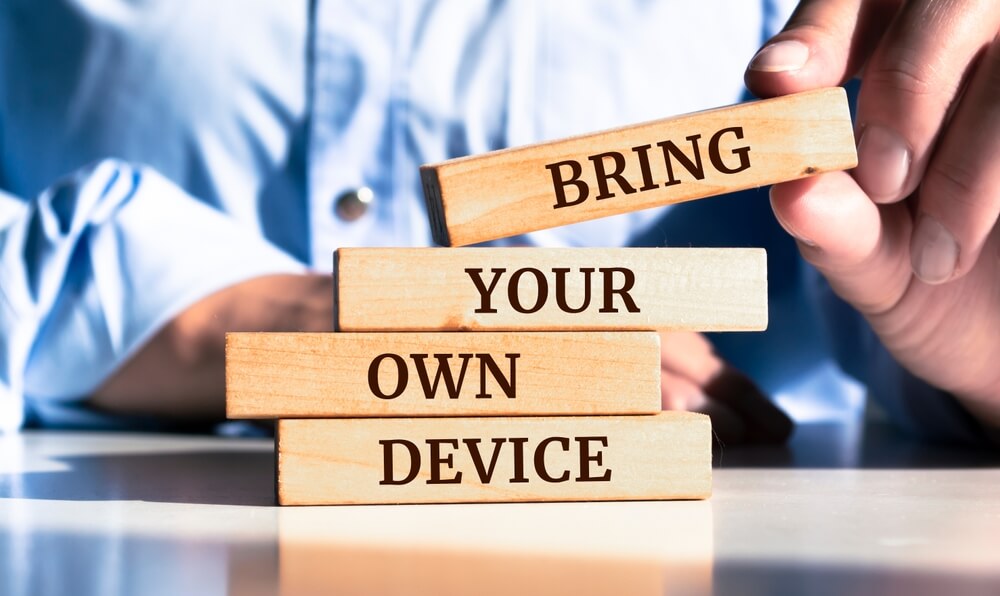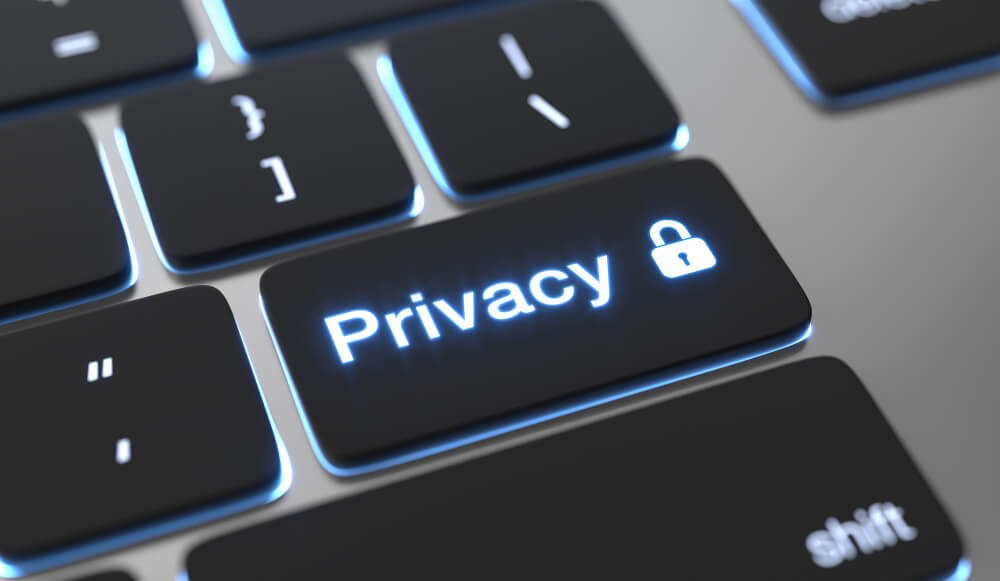If you're running a business, chances are you're always looking for ways to optimize your team's productivity while keeping your costs under control. Enter BYOD.
Allowing your employees to use their own devices for work purposes might seem like an attractive option. After all, it can:
- save you money on hardware,
- increase your employees’ flexibility and mobility,
- increase productivity, and
- promote a happier, more comfortable work environment.
What’s not to love? But before you let your employees fire up that iPad and start answering work emails from their couch, let's talk about how to create a BYOD security policy that keeps everyone happy and safe.

What is a BYOD security policy?
Bring Your Own Device (BYOD) is a business policy that allows employees to use their personal devices, such as laptops, smartphones, and tablets, for work purposes. BYOD goes hand in hand with remote work: 8 in 10 people are working either in a fully remote or hybrid environment (and the numbers are expected to rise, based on a 2022 AT&T study). But even if your employees are in the office most of the time, chances are they use at least their smartphone for things such as answering work emails.
95% of companies allow personal devices in some way in the workplace (source: Cisco), but only 39% of them implement a BYOD security policy (source: Trustlook). Can you spot the problem? That’s a BYOD data breach just waiting to happen!
To keep your company's data safe when employees use their own devices for work, it's crucial to have a BYOD security policy in place and talk about data protection. Basically, it’s a company’s way of controlling how employees use their personal devices when they’re using them to access company data.
By implementing a BYOD policy, you're taking important steps to control and protect your company's data. It helps you minimize the chances of data breaches, cyber-attacks, and other security risks that can come with BYOD.
So, ask yourself: Is your company ready to face the security risks that come with BYOD? Don't worry, we’ve got you covered.

How BYOD can be a threat for data security
When employees use their own devices for work-related tasks, they are basically bringing outside devices into the company's network, which can lead to various vulnerabilities. It can be challenging for IT teams to make sure that all devices are up to date with the latest security patches and antivirus software. It can also be tricky to monitor employees' activity on their personal devices without infringing on their privacy.
Additionally, if an employee installs unapproved software or accesses insecure websites on the device they use for BYOD, that could lead to malware and other cyber threats sneaking into the company system.
Remember, insider threats are on the rise due to digital workspaces, flexible and remote work, agile and BYOD approaches. The overall number of data loss incidents has increased by 44 percent in the last two years. Most of these threats are unintentional – 56% were caused by negligent insiders, whereas 26% were malicious.
One of the most significant risks of BYOD is that it can result in data breaches. Cybercriminals may attempt to gain access to a company's network by hacking into an employee device. They can then use this access to steal sensitive data or install malware (such as ever-popular ransomware).
Employees may also accidentally or intentionally share sensitive data with unauthorized parties, which can result in data leaks and compliance violations.
What are the advantages and disadvantages of BYOD?
While BYOD policies have their advantages, they also come with some challenges and pitfalls that businesses should be aware of when creating and enforcing their BYOD policies.
With all this talk of the security risks related to BYOD, is the bring-your-own-device model even worth considering at all?

Advantages of BYOD:
- Cost savings: BYOD can save companies money on hardware and software expenses since employees are using their own devices.
- Increased productivity: Working on familiar devices leads to increased productivity – there’s no time spent moving between personal and work devices, and since work is part of the device already, employees often find themselves working even outside of business hours.
- Greater flexibility and mobility: BYOD allows employees to work from anywhere and at any time, making it easier to stay connected.
- Attract and retain talent: Offering a BYOD policy can be a valuable perk for employees, making a company more attractive to job seekers and helping to retain current employees.
Disadvantages of BYOD:
- Security risks: BYOD can pose significant security risks, including the possibility of data breaches and malware attacks.
- Lack of control: With BYOD policies, companies have limited control over the devices their employees use, which can make it challenging to ensure that they comply with the company's standards and policies.
- Legal and privacy issues: BYOD policies require companies to strike a balance between protecting their data and respecting their employees' privacy rights. Employees may feel uncomfortable with their employers having access to their personal devices.
- Compatibility issues: Different devices may run different operating systems or software versions, which can create compatibility issues and make it difficult for IT teams to manage and maintain the company's network.
How can you prevent BYOD cyber attacks?
Keeping your company's data safe from the dangers of BYOD can be a tricky business. To tackle data security issues, companies have to create and implement strong BYOD policies that balance the benefits and risks of using personal devices for work. This includes defining the scope of BYOD, identifying supported devices and applications, enforcing data separation and encryption, providing security training and awareness, and controlling access and monitoring activities. Think of it as a necessary evil, but with a little guidance, you'll be able to keep your company’s data safe while making sure your employees are happy, too.
To take your BYOD security to the next level, consider implementing mobile device management software. This will allow your IT team to keep an eye on employee devices remotely, like a digital babysitter.
But it's not just about the tech. Educating your employees is key. Regular training on how to protect their devices and sensitive data, like spotting phishing scams and avoiding sketchy Wi-Fi networks, can go a long way. And don't forget the power of encryption to keep your data under lock and key.

How to create a BYOD policy?
Creating a BYOD policy might sound like a challenge, but it's important for companies that let employees use their own devices for work. A good policy helps keep things safe and sets clear rules for everyone to follow. It's like having a roadmap that guides employees on what they can and can't do with their devices.
By having a solid BYOD policy, you can reduce the chances of security problems and make sure everyone knows what's expected of them. A well-crafted BYOD policy is your secret weapon for smooth and secure operations. Here are some steps companies can take to create an effective BYOD policy:
Assess the risks and benefits of BYOD
Before you dive into creating a BYOD policy, take a moment to think about the possible risks and rewards for your organization. Doing a thorough risk assessment will help you target areas of concern and customize your policy to address them.
Once you have an understanding of what your company wants and needs, you can create a policy that’s tailored to those needs.
Define acceptable devices
The first step in creating a BYOD policy is defining which devices are acceptable for use in the workplace. It's important to establish a list of approved devices and operating systems, as well as any minimum hardware or software requirements.
Create clear usage guidelines
Once you have defined acceptable devices it's time to set some ground rules for how they should be used. This means coming up with guidelines for accessing, storing, and using data on these devices. You'll also want to consider any limitations on personal use of the device during work hours.
Address security concerns
Security is a primary concern when it comes to BYOD. Your policy should include measures to protect against data breaches, such as data encryption, firewalls, and password requirements. Additionally, you may want to consider implementing mobile device management software to help enforce your security policies.
Establish an incident response plan
No matter how strong your security measures are, there's always a chance of something going wrong. Your BYOD policy should include a clear incident response plan that outlines the steps employees should take in the event of a security breach or lost/stolen device. Being prepared and knowing what to do can help minimize the impact of these types of incidents and get things back on track as quickly as possible.
Include BYOD in your offboarding process
It's crucial to tailor your offboarding plan to every possible termination situation your company could face, and that includes considering how you’ll handle data on and access from employees’ personal devices.
Managing employee expectations with BYOD
BYOD can be a great way to improve productivity and flexibility, but it also requires a certain level of responsibility from employees.
Here are some tips for managing employee expectations and responsibilities with BYOD:
- Clearly communicate the policy: Your employees need to understand the BYOD policy's purpose and requirements, so make sure to communicate it clearly, and provide regular updates and reminders to ensure everyone is aware of their responsibilities.
- Provide training and support: Not all employees will be familiar with the ins and outs of BYOD, so it's important to provide training and support to help them get up to speed. This could include training on security best practices, as well as technical support for setting up and using their devices.
- Address employee privacy concerns: Employees may worry that their personal data will be monitored or accessed by their employer. To put their minds at ease, it's crucial to be upfront and clear about what information the company can access and why they need it. It's also important to ensure that the company is complying with all relevant privacy laws and regulations.
- Monitor usage: Even with a solid BYOD policy in place, it's important to monitor usage to ensure employees are complying with the policy. This could include monitoring data usage, access logs, and device configurations, as well as regular security audits.
- Establish consequences for policy violations: In some companies, it can make sense to include consequences for policy violations in your BYOD security policy.
Step up your security game with Safetica’s DLP solutions
A solid BYOD policy is a must-have for companies looking to embrace remote work and the perks of the BYOD model. But is it enough? There will always be security risks and challenges associated with BYOD, and any responsible business owner will take proactive steps to mitigate them.
By utilizing a reliable DLP solution like Safetica, you can make sure that your company's valuable data stays safe and sound even if your data security falls through the cracks of your BYOD policy.
A good data loss prevention (DLP) software can play a crucial role in securing your company's sensitive information, and it just so happens that we at Safetica have some unique selling points up our sleeve:
- Easy to use: Safetica's solutions are easy to implement and simple to use, which means that they do not create extra hassle for your IT or other employees.
- Comprehensive protection: Safetica offers all-in-one data prevention with enterprise-level DLP, 3rd party integrations, and regulatory compliance support.
- Customizable policies: Safetica's policy templates and automation can be customized to suit your company's specific needs, making it easy to create and enforce BYOD policies.
- Real-time monitoring: Safetica provides real-time monitoring and alerts, allowing you to detect and respond to potential data breaches before they become serious.
- User-friendly interface: Safetica's user-friendly interface makes it easy for your IT team to manage your BYOD policy and enforce data protection policies.
- Cost-effective: Safetica offers a cost-effective solution to protect your business's sensitive information and prevent data breaches, saving your company money in the long run.
Next articles

Hidden Data Everywhere: Why It’s Important to Have Complete Visibility for Data Security
Modern work creates blind spots across shadow IT, AI tools, personal devices, and third-party services. This article explains why visibility is essential for effective data discovery and stronger data protection.

